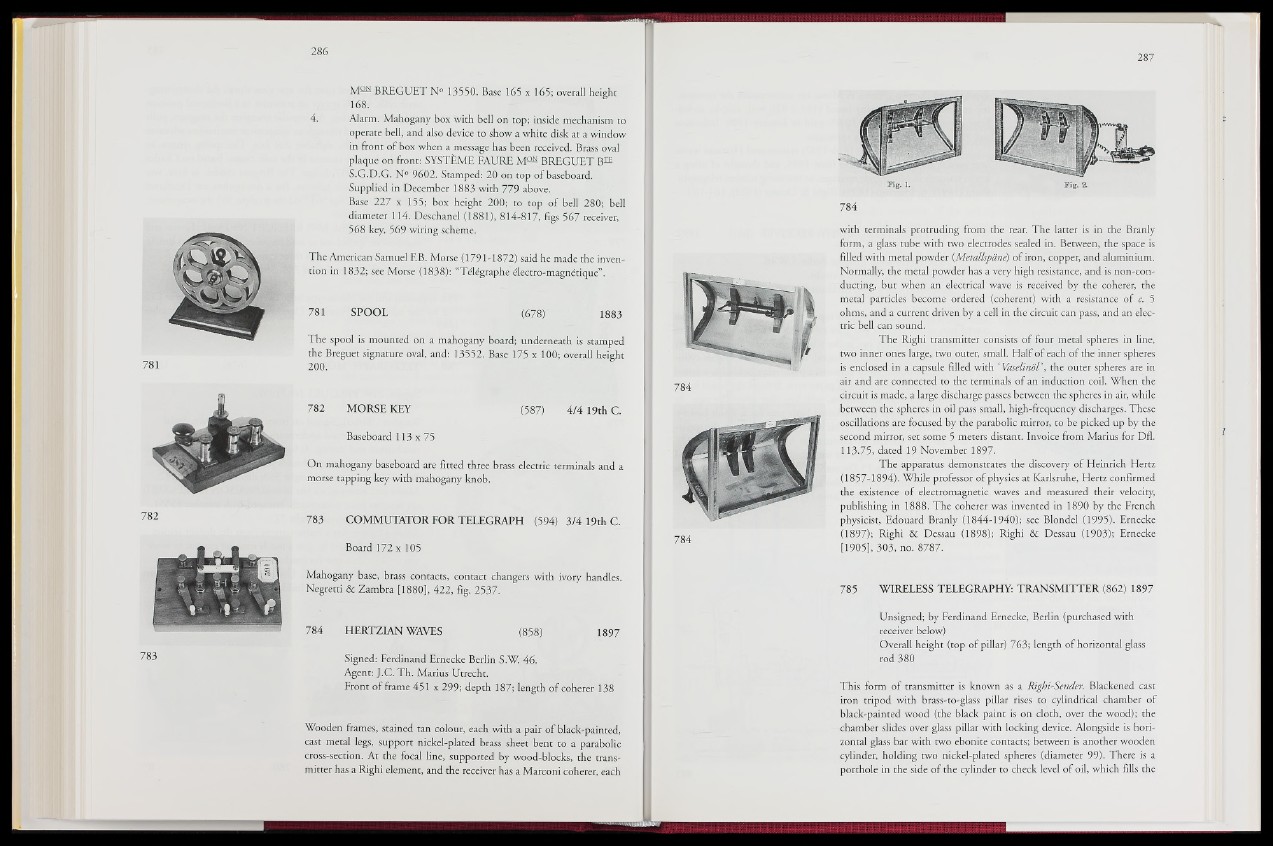
M— BREGUET N° 13550. Base 165 x 165; overall height
168.
4. Alarm. Mahogany box with bell on top; inside mechanism to
operate bell, and also device to show a white disk at a window
in front of box when a message has been received. Brass oval
plaque on front: SYSTÈME FAURE M®-BREGUET B12
S.G.D.G. N° 9602. Stamped: 20 on top of baseboard.
Supplied in December 1883 with 779 above.
Base 227 x 155; box height 200; to top of b e l 280; bell
diameterT14. Deschanel (1881), 8 14- 817, figs 567 receiver,
568 key, 569 wiring scheme.
The American Samuel F.B. Morse (1791-1872) said he made the invention
in 1832; see Morse (1838): "Télégraphe électro-magnétique”.
781 SPOOL (678) 1883
The spool is mounted on a mahogany board; underneath is stamped
the Breguet signature oval, and: 13552. B a se ^H x 100; overall height
200.
782 MORSE KEY (587) ‘ 4/4 19th C.
Baseboard I 13 x 75
On mahogany baseboard are fitted three brass electric terminals and a
morse tapping key with mahogany knob.
783 COMMUTATOR FOR TELEGRAPH (594) 3/4 19th C.
Board If 2 x 105
Mahogany base, brass contacts, contact changers with ivory handB.
Negretti & Zambra [1880], 422, fig. 2537.
784 HERTZIAN WAVES (85w ' : i897
Signed: Ferdinand Ernecke Berlin S.W. 46.
Agent: J.C. Th. Marius Utrecht.
Front of frame 451 x 299; depth 187; length of coherer 138
Wooden frames, stained tan colour, each with a pair of black-painted,
cast metal legs, support nickel-plated brass sheet bent to a parabolic
cross-section. At the focal line, supported by wood-blocks, the transmitter
has a Righi element, and the receiver has a Marconi coherer, each
Fiff. i.
784
784
784
with terminals protruding from the rear. The latter is in the Branly
form, a glass tube with two electrodes sealed in. Between, the space is
filled with metal powder (Metallspane) of iron, copper, and aluminium.
Normally, the metal powder has a very high resistance, and is non-conducting,
but when an electrical wave is received by the coherer, the
metal particles become ordered (coherent) with a resistance of c. 5
ohms, and a current driven by a cell in the circuit can pass, and an electric
bell can sound.
The Righi transmitter consists of four metal spheres in line,
two inner ones large, two outer, small. Half of each of the inner spheres
is enclosed in a capsule filled with ‘Vaselm'oV, the outer spheres are in
air and are connected to the terminals of an induction coil. When the
circuit is made, a large discharge passes between the spheres in air, while
between the spheres in oil pass small, high-frequency discharges. These
oscillations are focused by the parabolic mirror, to be picked up by the
second mirror, set some 5 meters distant. Invoice from Marius for Dfl.
113.75, dated 19 November 1897.
The apparatus demonstrates the discovery of Heinrich Hertz
(1857-1894). WTiile professor of physics at Karlsruhe, Hertz confirmed
the existence of electromagnetic waves and measured their velocity,
publishing in 1888. The coherer was invented in 1890 by the French
physicist, Edouard Branly (1844-1940); see Blondel (1995). Ernecke
(1897); Righi & Dessau (1898); Righi & Dessau (1903); Ernecke
[1905], 303, no. 8787.
785 WIRELESS TELEGRAPHY: TRANSMITTER (862) 1897
Unsigned; by Ferdinand Ernecke, Berlin (purchased with
receiver below)
Overall height (top of pillar) 763; length of horizontal glass
rod 380
This form of transmitter is known as a Righi-Sender. Blackened cast
iron tripod with brass-to-glass pillar rises to cylindrical chamber of
black-painted wood (the black paint is on cloth, over the wood); the
chamber slides over glass pillar with locking device. Alongside is horizontal
glass bar with two ebonite contacts; between is another wooden
cylinder, holding two nickel-plated spheres (diameter 99). There is a
porthole in the side of the cylinder to check level of oil, which fills the